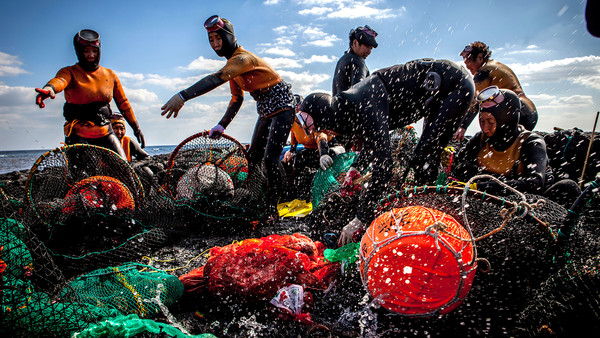
Female divers, or “haenyeo” in Korean, celebrate as they hold the Olympic flame for the 2018 PyeongChang Games as part of the torch relay on the southern resort island of Jeju on Nov. 3, 2017. (Yonhap)

A group of children wearing the costume of “haenyeo,” female divers on South Korea’s southern Jeju Island, wait for their turn at an event to mark the anniversary of the listing of haenyeo as a UNESCO cultural heritage at a park in Seoul on Oct. 30, 2017. The listing was decided at the U.N. culture body’s meeting in Addis Ababa, Ethiopia, on Dec. 1, 2016. (Yonhap)
South Korea has another cultural property recognized by UNESCO:

Female divers of Jeju Island made it into the UNESCO’ cultural heritage list Thursday, boosting South Koreans’ hopes to preserve the traditional symbol of women’s empowerment and attract more tourists to the resort island.
The United Nations Educational, Scientific and Cultural Organization on Wednesday added “haenyeo,” or sea women, to its list of Intangible Cultural Heritage of Humanity during a session in Addis Ababa, Ethiopia.
It marks Korea’s 19th cultural asset to win the world body’s heritage status.
UNESCO’s intangible cultural heritage committee said the haenyeo culture shows a region’s unique cultural identity and cultural diversity. The listing is expected to raise awareness of the importance of jobs for women and promote communication with other communities with traditions similar to haenyeo, it said.
The world organization also said the haenyeo culture reflects female empowerment, best represented by haenyeo’s inclusion in the workforce. [Yonhap]
You can read more at the link.

A group of “haenyeo,” or female divers, parade as part of an event to mark the 9th Jeju Haenyeo Festival held on the southern resort island of Jeju on Sept. 24, 2016. The two-day event, which kicked off on the day, includes various activities to introduce the female divers to visitors. (Yonhap)
Below is a good read in the Financial Times about Cheju’s female divers called “haenyeo” for those that have not read about them before. I think what will end the haenyo tradition is the small pay the hard work earns. A top haenyeo earns up to $25,000 a year, most earn half that number according to the article requiring them to often work second jobs as farmers:

Each of the elderly women utters a distinctive cry as they surface around me from the bitterly cold East China Sea, clutching fistfuls of seaweed. From my left comes a sound like the bleating of a goat; ahead, a determined groan of endurance. All of them are whistling too, an ancient technique to expel carbon dioxide from the lungs. Occasionally, the wetsuit-clad grandmothers exchange a few words after depositing their seaweed in sacks tied to orange buoys beside them. But none of them rests for more than a minute before plunging to the seabed once more — a rhythm they maintain for five hours.
These are the haenyeo (sea women) of South Korea’s Jeju island, who have dived in search of seaweed and shellfish since at least the 17th century. Their work is one of the country’s most celebrated traditions but one that many islanders fear could soon be consigned to the past.
Traditionally a job handed down from mother to daughter, haenyeo life has been shunned in recent decades by nearly all the girls born in Jeju’s seaside villages, who have tended to favour more comfortable lives in the island’s two cities or on the mainland. From more than 14,000 in the 1970s, the number of haenyeo has dwindled to fewer than 4,500 today. [Financial Times]
You can read the rest at the link and I recommend watching the video included with the article as well.







